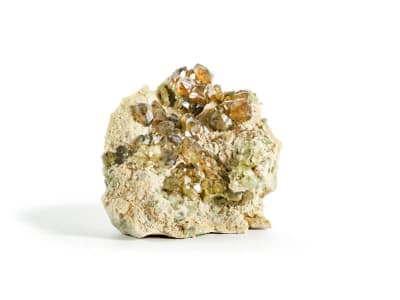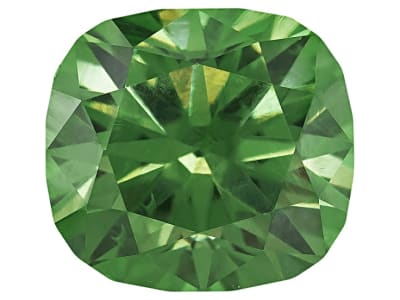Demantoid is a rare, attractive yellowish green to intense rich emerald green variety of andradite garnet. The rich green color is due to trace amounts of chromium. Demantoid gets its name from the German word demant that translates to diamond. This is an allusion to its diamond like luster. Demantoid was discovered in Russia in 1868 during the reign of Alexander II. It was held in high regard by the Russian royal family and was the gemstone of choice for many Fabergé creations. Fibrous, wispy inclusions of byssolite or chrysotile known as horsetail inclusions are prized in demantoid garnets.
General Information
LWUV: Inert
Demantoid Colors
-
 Green
Green -
 Green
Green
Demantoid Spectra
We acknowledge the significant scientific contributions of John S Harris, FGA to the study of gemstone spectra and with deep appreciation to him, acknowledges the use of his images and related notes about gemstones and their spectra in the educational materials on this website.
Countries of Origin
Afghanistan; Russian Federation; United States of America; Madagascar; Pakistan; Unknown; China; Slovakia; France; Nigeria; Argentina; Iran (Islamic Republic of); Sri Lanka; Japan; Kenya; Switzerland; Spain; Canada; Turkey; Namibia; Congo (the Democratic Republic of the); Italy; Mexico; Germany; Tajikistan
History
In the gemstone universe there are many desirable, beautiful stones. Demantoid is one that stands with the best and the brightest. First, it is extremely rare because it is a color variety of the andradite garnet. Let's start with its green... delicious, deep-lime shades with golden-yellow flashes. The range goes from the most intense to more moderate shades. Wherever your stone lands in depth of shading, it will still hold the essence of that incomparable green, for which it can thank chromium. Demantoid is also revered for its diamond-like sheen, in fact, its name comes from the German "demant" meaning diamond-like. Well-cut demantoid has superior sparkle and fire, which makes it a very satisfying gem to own and wear. The rarest, and therefore most expensive, of all demantoids have a golden, whip-like inclusion called a horsetail. Most frequently seen in Russian stones, horsetails have been present in stones from Italy and Iran as well. This gem was originally mined in Russia around the mid-19th century before mining ceased at the time of the 1917 Russian Revolution. We are delighted that independent miners are discovering stream-worn demantoids in several areas around Ekaterinburg today. Slowly, these newly found stones are finding their way into the marketplace.
Care
Normal Care

More About Demantoid
Once revered as the Czar of the garnet family, the demantoid has many historical ties to the court of Nicolas II of Russia. Demantoid's regal past includes the works of Karl Fabergé. Perhaps the lush green of the demantoid accounts for the historical belief that it could boost vitality
Optical Phenomena
Cat's-Eye
The term cat's eye, or chatoyancy, is used to describe a phenomenal optical property in gemstones, in this case demantoid garnet. The effect, when present, appears as a bright, narrow slit like the pupils in the eyes of your favorite feline. This phenomenon is caused by parallel fibrous or needle-like inclusions that interfere with the passage of light throughout the crystal, scattering and reflecting light back to the viewer as a thin line. Demantoid garnets that feature a cat's eye are rare.


